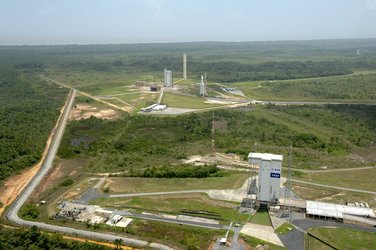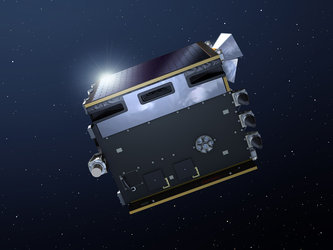Launch site
Proba-V was launched from Europe’s Spaceport, in the northeast of South America in French Guiana, an overseas department of France.
The Vega launch site is located at the previous ELA-1 complex, originally used for Ariane 1 and Ariane 3 missions.
The pad and infrastructure have been adapted to meet Vega’s requirements. It retains the original flame ducts, which channel Vega’s exhaust gases during ignition and liftoff. A new fixed umbilical mast provides power and environmental control connections to the launcher and its payloads from mission preparation to the final countdown and liftoff.
Launcher preparation takes place on the pad inside a mobile gantry that houses all the support equipment to assemble and check the vehicle. The gantry provides a protected environment for launch personnel. Its height is 50 m and weighs more than 1000 t.
The Operational Control Centre for Vega is in the Launch Control Centre built for Ariane 5. It houses Vega’s operational and monitoring systems.
Vega payloads benefit from Ariane 5’s state-of-the-art facilities. The payload preparation buildings accommodate satellite and control equipment unpacking, mechanical assembly work, electrical and mechanical inspections, and checkout of the various platform and payload subsystems.
Final integration of the payload composite takes place at the complex before its transfer to the launch pad for hoisting onto the top of the launcher.
The launch site at Kourou lies at latitude 5°3', just over 500 km north of the equator. Its nearness to the equator makes it almost ideally placed for launches into geostationary transfer orbit because few changes have to be made to a satellite’s trajectory.
Launchers also profit from the ‘slingshot’ effect, that is the energy created by the speed of Earth’s rotation around the axis of the poles. This increases the speed of a launcher by 460 m/s. These important factors save propellant and money, and prolong the active life of satellites.
Thanks to its geographical position, Kourou offers a launch angle of 102° from east to north, enabling a wide range of missions. In fact, Europe’s Spaceport is so well placed that it can carry out all possible space missions.
Safety is equally important. French Guiana is sparsely populated and 90% of the country is covered by equatorial forests. In addition, there is no risk of cyclones or earthquakes.















 Germany
Germany
 Austria
Austria
 Belgium
Belgium
 Denmark
Denmark
 Spain
Spain
 Estonia
Estonia
 Finland
Finland
 France
France
 Greece
Greece
 Hungary
Hungary
 Ireland
Ireland
 Italy
Italy
 Luxembourg
Luxembourg
 Norway
Norway
 The Netherlands
The Netherlands
 Poland
Poland
 Portugal
Portugal
 Czechia
Czechia
 Romania
Romania
 United Kingdom
United Kingdom
 Slovenia
Slovenia
 Sweden
Sweden
 Switzerland
Switzerland




























